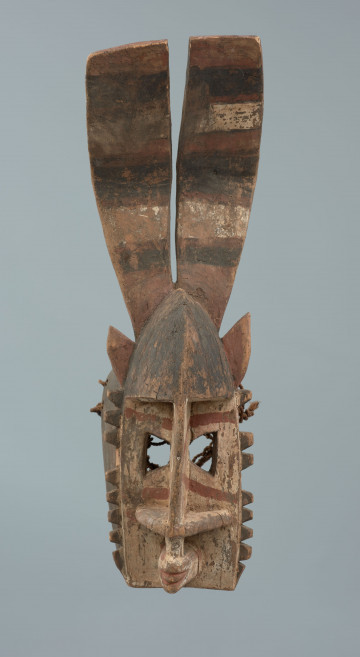
Gomintogo mask
między 1951 — 2000
National Museum in Szczecin
Part of the collection: Collection of Dogonian art
The myth of the origin of masks was noted by Marcel Griaule in the 1930s. The inventors of the masks were the Andumbulu, lowly people living in the bush. One day, when the Dogon still lived in Mande country, two women working in the fields heard the sound of drums and followed the music curiously. In a small clearing in the bush they saw the Andumbulu who were dancing, singing and drinking beer at the altar of buguturu. Next to the altar, an old man named Albarga was sitting on an iron dolaba (seat). The Andumbulu performed Sigi rituals in honour of their dead and sang thanks to old Albarga, who provided them with millet beer. The women returned to the village and one of them reported everything to her husband. He ordered her to return to the bush and bring back the items she had told about. When she returned to the site the Andumbulu were still celebrating. The woman threw a stone at the old man in an attempt to chase them away. The gathering fled in fright, abandoning all their belongings and the stone-struck Albarga in their haste. The woman dressed herself in the fibres she had found and returned to the village. All the inhabitants became extremely frightened at the sight of her and fled the village. The men then saw the potential in the objects that had previously belonged to the Andumbulu, the power to gain dominance, and they tricked the woman into taking them away. Out of fear of the women and the subsequent theft, they hid the masks in a place on the outskirts of the village, commonly referred to as the shelter. In the same place lived Andumbulu Albarga, captured by the Dogon, who explained to the men the secrets of the masks and taught them how to handle them properly. Over time, as the result of successive mutual thefts, the masks spread among the Dogon villages.
Ewa Prądzyńska
Author / creator
Dimensions
cały obiekt: height: 65,5 cm, width: 15,5 cm
Object type
sculpture, mask
Creation time / dating
Creation / finding place
Identification number
Location / status

między 1951 — 2000
National Museum in Szczecin

między 1951 — 2000
National Museum in Szczecin

między 1951 — 1998
National Museum in Szczecin
DISCOVER this TOPIC
National Museum in Lublin
DISCOVER this PATH
Educational path